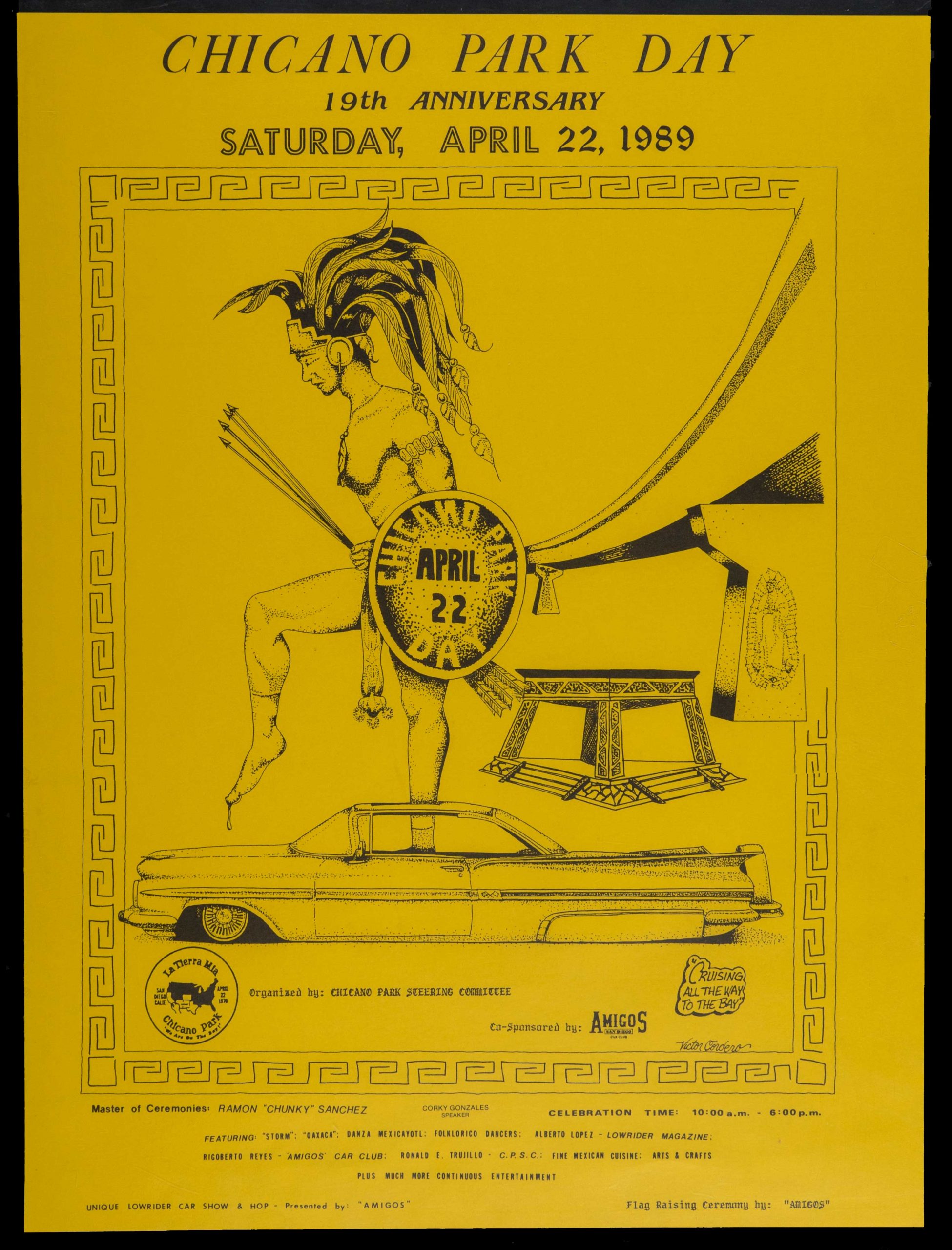The 1989 Chicano Park Day poster titled, Cruising All The Way to The Bay, by Victor Cordero incorporates the cultural tradition of “Cruising” in the community. The poster features an Aztec warrior and a lowrider at its feet. There is also the quote “Cruising All The Way To The Bay”, which ties the activism of the cruising community and the community as a whole. “All The Way to The Bay” refers to the campaign led by Ronnie Trujillo in which Barrio Logan asserted the community’s access to the bay and to extend the neighborhood to the waterfront. It is also in reference to one of Chicano Park’s prominent murals created by Victor Ochoa in 1978. On the pillars of the Coronado bridge reads “All The Way to The Bay” and “Hasta La Bahia”. Although too many the low-riders has a negative image, the term cruising represents the preservation of lowrider history that consists of culture and tradition. Most importantly, it is centered around its core of Chicanismo beliefs that align with Chicano Park’s community. Both organizations emphasize on sharing their history for all generations while they are still around to accurately depict their history to others.
Cruising was at its peak in San Diego on Highland Avenue in National City. The street was an optimal place for the activity to take place for low-riders coming from the north and south. Seen more as a community event, cruising would take place starting on Friday evenings through Sunday. Drawing in low=riders from all over the San Diego region and borderlands, the street traffic brought some businesses to complain about them which eventually brought the city to ban cruising all together. With Highland Avenue closed, Barrio Logan became a center for some of today’s biggest lowrider events. Amigos Car Club was a lowrider club in Chicano Park, that eventually became very involved in the preservation of Chicanismo for both low-riders and the community. As in 1989, Chicano Park continues to incorporate the art of cruising at many of the community’s biggest events to the public including Chicano Park Day.
Additionally, the poster shows the Coronado bridge. In 1967, the city decided to build it directly on top of the community displacing hundreds of families in the process. Although the construction of the bridge was devastating to many people living in Barrio Logan, community members were able to recapture the space through the use of art. In 1973, local artist Salvado Torres, who had lost him due to the construction of the bridge, and Victor Ochoa started to organize with local artists and began to paint over the concrete columns as a sign of their displeasure with what the bridge did to the people of Barrio Logan. It was done to reclaim the space that the city took from them. As the years have passed, dozens of murals have been created on what used to be bridge columns. When in the park today, you no longer see them as freeway columns but as part of the park, part of the community. Seeing that is displayed in the 1989 Chicano Park Day poster, it is clear that the community is proud of what the bridge symbolizes now. It will forever be a reminder of not simply what the bridge did to the community, but how they were able to recapture the space through the power of beautiful murals by local artists.
Tatum, Charles M. Lowriders in Chicano culture: From low to slow to show. ABC-CLIO, 2011.
Video of “Amigos” Lowrider club, the same club represented at Chicano Park Day 1989
https://youtu.be/RLwDab4cUuI
Video of “San Diego’s Lowrider History Documented”
https://youtu.be/r7oVfzwtJjk
Pulido, Alberto L., and Rigo Reyes. San Diego Low-riders: a History of Cars and Cruising. The History Press, 2017.
Tebor, Celina. “New Mural in Chicano Park Celebrates the History of Lowriding.” Tribune, San Diego Union-Tribune, 11 Nov. 2019, www.sandiegouniontribune.com/entertainment/visual-arts/story/2019-11-11/new-mural-in-chicano-park-celebrates-the-history-of-lowriding.
Written by Riley Reyes

